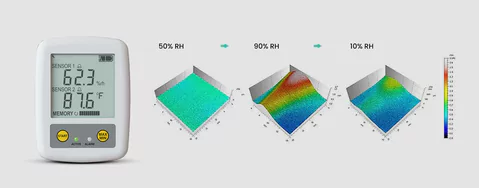
Let’s discuss the problem caused by too high or too low moisture levels in the air. It includes:
Here are some best practices in Printing humidification. These will help you manage humidity levels. By doing this, it will keep your printing process smooth.
Always maintain the right humidity level.
What do you mean by wrinkling?
Suppose the level of moisture is higher in the air. In that case, paper can absorb humidity. This can lead to “curling”. You can also say it wrinkling.
Whereas, if the air is too dry, the paper may become brittle. It results in static buildup. This can cause paper jams.
You can avoid these problems by maintaining a stable RH level.
You have to check the humidity levels regularly in your printing environment. For this, use a hygrometer. This tool is used to measure the moisture level in the air
Both of these are effective tools for Printing humidification.
It is necessary to keep the Paper in a controlled environment.
The storage area for your paper should have stable humidity and temperature levels. These have to be the same as those in the printing space. This will help prevent the paper from absorbing too much moisture or drying out.
A bad quality paper can lead to poor print quality. This results in paper jams.
Paper can easily absorb moisture from the air.
Your paper may have been stored in an area with a different temperature or humidity level than your printing room. In that case, let the paper adjust to the printing room environment before using it. This process is called acclimatization.
Simply leave the paper in the printing area for a few hours. This way it can adapt to the room’s conditions. This step can prevent the paper from warping or curling when it is used for printing.
To reduce the risk of moisture problems, install an air barrier in your printing facility. This is an important part of Printing humidification.
The barrier can control the movement of air between different areas of the building.
Your printing space may draw in air from outside. In that case, dehumidify that air before it enters the facility.
Outdoor air has a higher moisture content. It increases during rainy seasons. In this situation, you can use an outdoor air dehumidifier. It reduces the amount of moisture entering your printing space. This can keep the humidity level stable.
An exhaust fan can create a slight negative pressure in the room. This means that more air is leaving the room than entering it.
It affects the quality of your prints.
For example, static electricity can build up if the humidity is too low.
This causes the paper to stick together. It resulted in paper jams in the printer. This will no doubt, slow down your work.
In an environment with high RH levels, the toner may not adhere properly to the paper.
Conclusion
In a printing environment, you have to maintain a RH level. This is essential for smooth operations and obtaining high-quality results. Taking simple steps to monitor and manage RH levels can make a big difference in the quality of your prints.
Contact Hydrofogger for the best humidifiers for your printing setup. We have a skilled support team to assist you if required.
Stay updated with the latest news, tips, and exclusive offers by subscribing to our newsletter! Join our community to receive valuable insights directly in your inbox. Don't miss out—sign up today and enhance your experience with us!